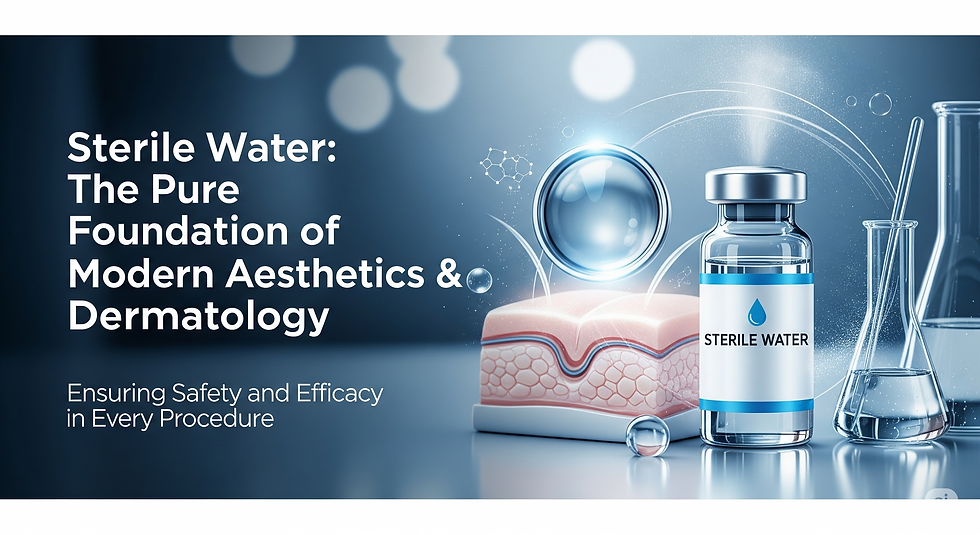Sterile Water in IV Therapy: A Key Factor in Hemolysis Prevention
- Bacteriostatic Water Australia
- May 6
- 4 min read
Every intravenous (IV) therapy component is pivotal in ensuring patient safety and treatment efficacy. Sterile water is a fundamental element, particularly in preventing hemolysis, a condition in which red blood cells rupture, leading to potentially serious complications.
This blog delves into the critical role of sterile water in IV therapy, exploring its types, applications, and how it helps avert hemolysis.
Understanding Sterile Water in IV Therapy
Sterile water is purified and free from microorganisms, making it safe for medical use. In IV therapy, it’s used as a diluent for medications, rehydration solutions, and other intravenous fluids. The purity of this water is paramount, as any contamination can lead to infections or adverse reactions in patients.
The Role of Sterile Water in Preventing Hemolysis
Hemolysis occurs when red blood cells are damaged and release their contents into the bloodstream. In IV therapy, improper dilution or the use of incompatible fluids can lead to hemolysis. Here’s how sterile water plays a crucial role in preventing this condition:
1. Proper Dilution of Medications
Medications administered via IV often require dilution to achieve the correct concentration. Using sterile water ensures that the dilution process does not introduce contaminants that could react with the medication or the patient’s blood cells, thereby preventing hemolysis.
2. Maintaining Osmolarity Balance
Sterile water helps maintain the osmolarity balance of intravenous fluids. If the osmolarity is too low (hypotonic), water can enter red blood cells, leading to swelling and rupture. Conversely, hypertonic solutions can draw water out of cells, causing dehydration. Using sterile water allows healthcare providers to precisely control the osmolarity of IV solutions, thereby safeguarding against hemolysis.
3. Compatibility with Blood Products
The compatibility of IV fluids when administering blood products is critical. Sterile water ensures that the solutions used do not adversely interact with blood components, reducing the risk of hemolytic reactions.
Advantages of Using Bacteriostatic Water
While bacteriostatic water is not typically used for primary IV solutions, it offers specific advantages that complement sterile water in various clinical scenarios:
Extended Shelf Life: The bacteriostatic agent in bacteriostatic water prevents bacterial growth, allowing multi-dose vials to be used safely over a more extended period.
Reduced Risk of Contamination: Bacteriostatic water minimizes the risk of contamination, especially in settings where multiple doses are drawn from a single vial. By maintaining the integrity of the IV solution, bacteriostatic water indirectly contributes to hemolysis prevention.
Why 10 ml Sterile Water for Injection is Essential
The 10 ml sterile water for injection is a staple in many clinical settings due to its versatility and precision. Its benefits include:
Precision Dosing: The small volume allows for accurate dilution of potent medications, ensuring that patients receive the correct dosage without the risk of over-concentration that could lead to hemolysis.
Minimized Waste: The 10 ml size is ideal for medications that require only small amounts of diluent, reducing waste and ensuring cost-effective treatment.
Portability: Its compact size makes it easy to store and transport, making it a convenient option for various medical procedures and emergencies.
Best Practices for Using Sterile Water in IV Therapy
To maximize the benefits of sterile water and minimize risks associated with IV therapy, healthcare professionals should adhere to the following best practices:
Ensure Sterility: Always use sterile water from sealed, uncontaminated sources. Inspect the packaging for integrity before use.
Proper Dilution: Follow manufacturer guidelines and clinical protocols for diluting medications, paying close attention to osmolarity and compatibility.
Monitor Patient Response: Monitor patients for any signs of hemolysis or adverse reactions, especially when introducing new IV solutions.
Educate Healthcare Staff: Regular training on properly handling and administering sterile water and other IV fluids ensures that best practices are consistently followed.
Ensure your medical facility is equipped with high-quality sterile water and trained staff to enhance IV therapy safety. Contact Bacteriostatic Water Australia to get quality sterile water products to support your healthcare team.
Summary
In summary, sterile water is more than just a diluent in IV therapy; it’s critical to ensure patient safety and prevent hemolysis. By understanding the different types of sterile water and their applications and adhering to best practices, healthcare providers can optimize IV therapy outcomes and safeguard against complications. As the medical field continues to evolve, the importance of sterile water in IV therapy remains steadfast, underscoring its role as a cornerstone of effective and safe patient care.
FAQs
Q1. What is the difference between sterile water and bacteriostatic water?
Ans. Sterile water for injection (SWI) is pure water without any additives and is suitable for single-dose use. Bacteriostatic water contains a bacteriostatic agent that inhibits bacterial growth, making it ideal for multi-dose vials and reducing the risk of contamination over time.
Q2. Can sterile water cause hemolysis if not used correctly?
Ans. Yes, improper use of sterile water, such as incorrect dilution leading to hypotonic solutions, can disrupt the osmolarity balance and cause hemolysis. To prevent such complications, it’s crucial to follow precise guidelines for dilution and administration.
Q3. Why is 10 ml sterile water for injection preferred in certain clinical settings?
Ans. The 10 ml sterile water for injection is preferred for its precision in dosing, minimal waste, and portability. It’s particularly useful for diluting potent medications that require small volumes of diluent, ensuring accurate and cost-effective treatment.



Comments